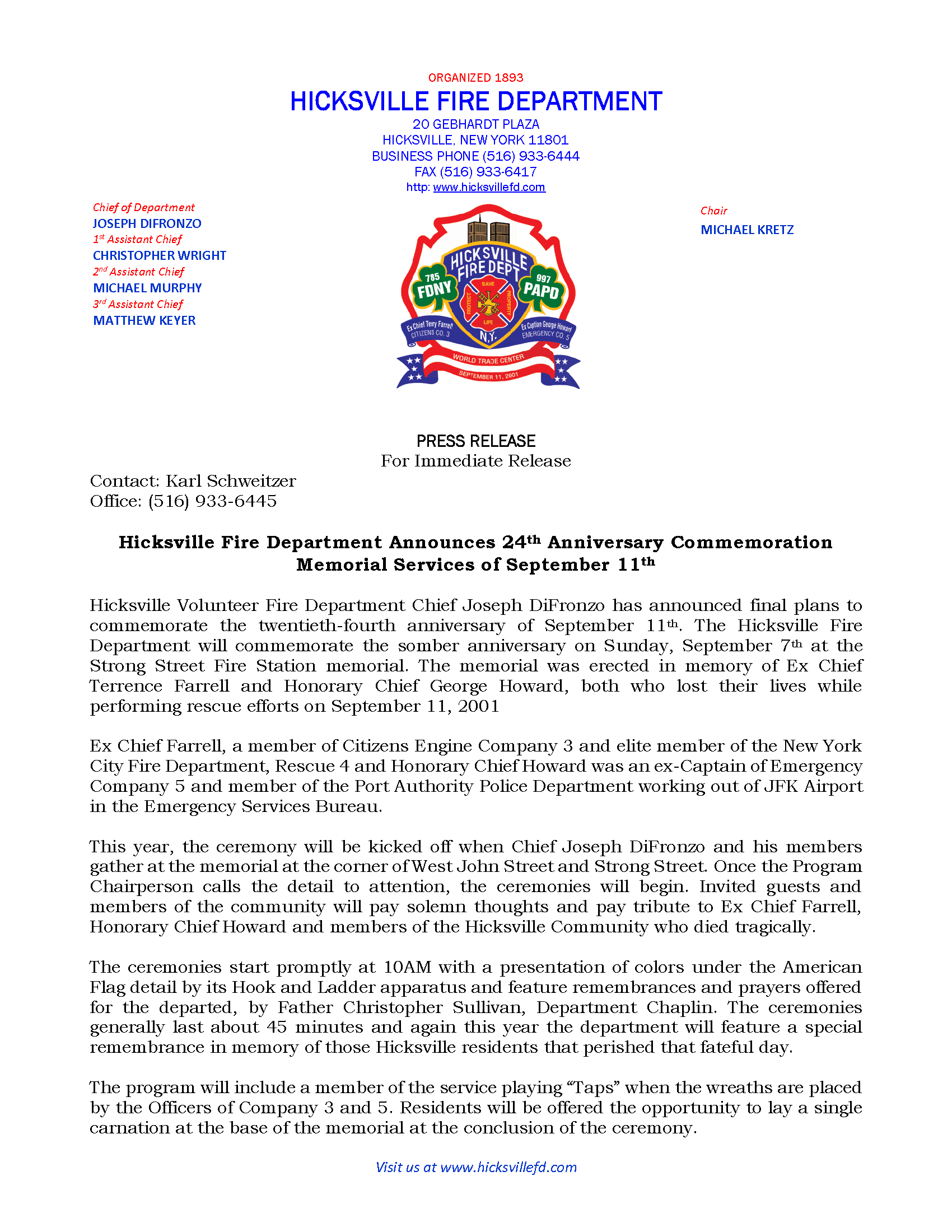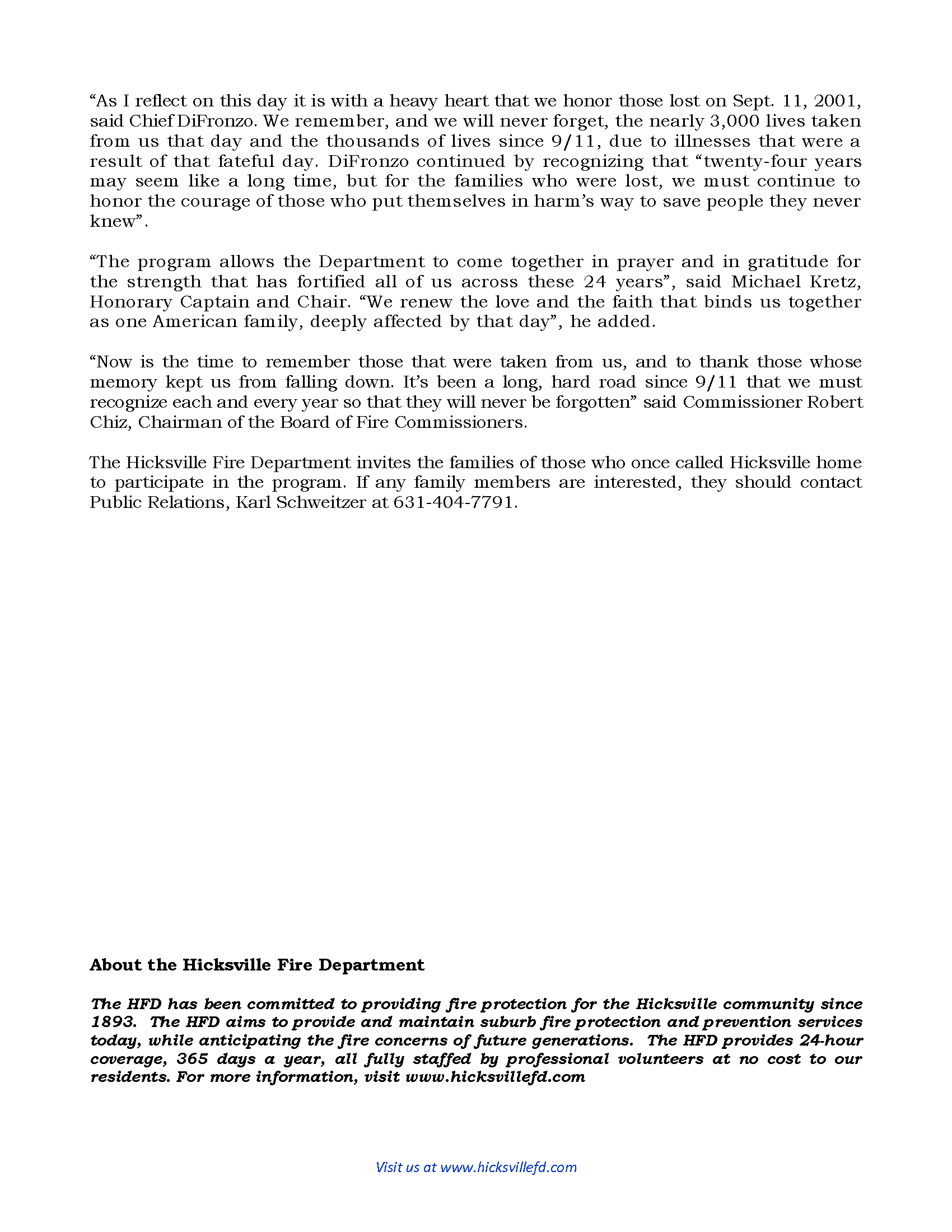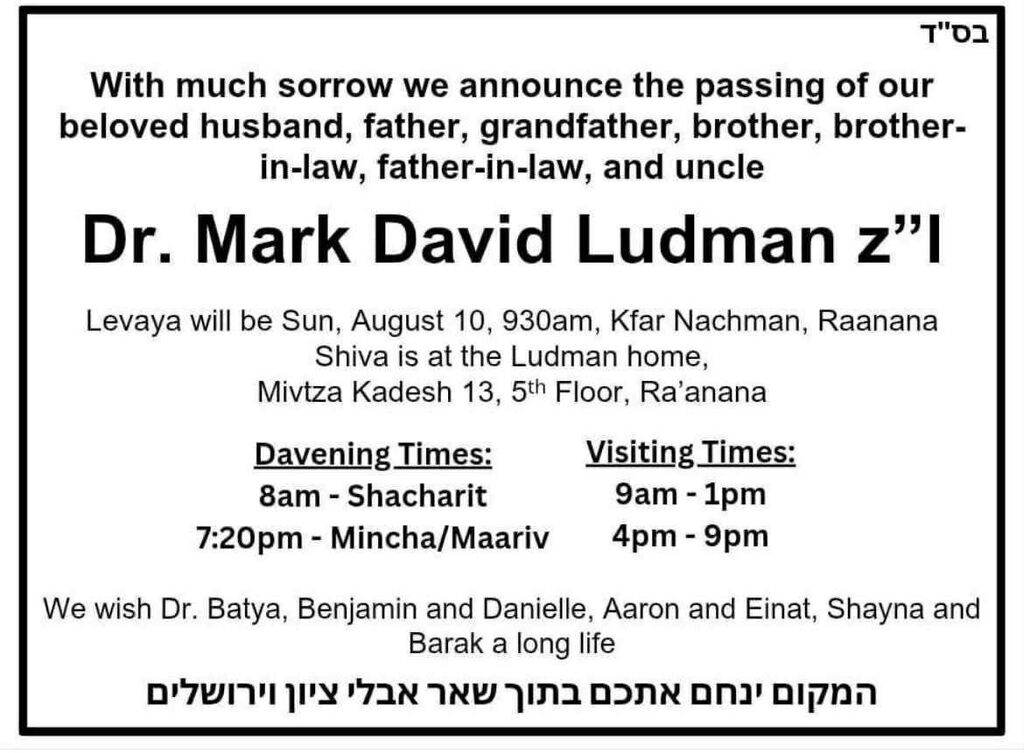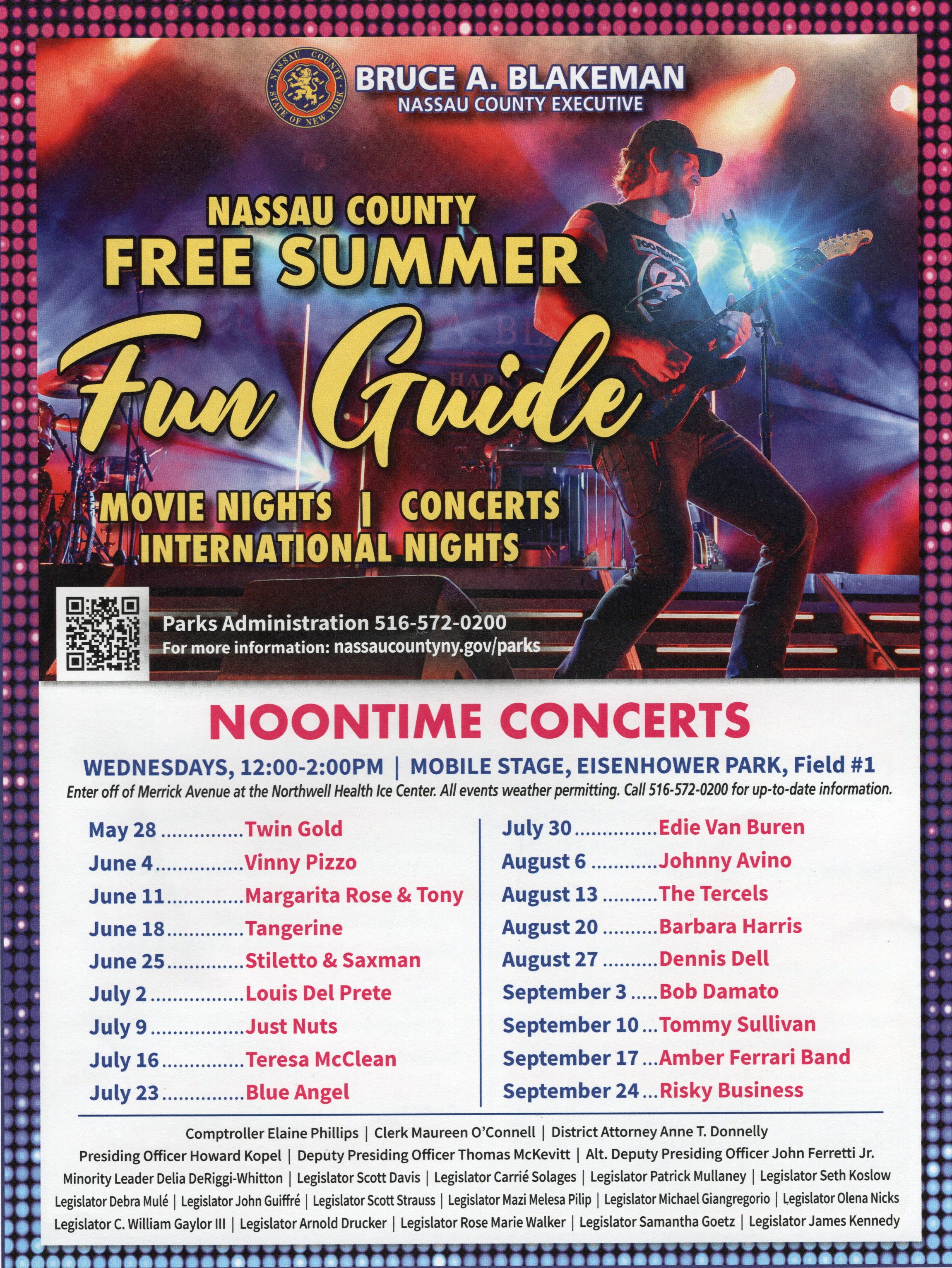 Dear Readers,
Dear Readers,
We are continuing to collect articles about BOCES and hope to publish them next month. Please email us at
The Editors
View The Hix News Team
Editors:
- Wendy Elkis Girnis '77
- Stefanie Cedar Shames '77
- Ron Wencer '64
Webmasters:
- Bruce Scherzinger (spouse of Eileen Goldstein '77)
- Gail Schwartzman Mayer '73
- Matt Kennedy '08
- Roger Whitaker (Webmaster Emeritus)
- Karl Schweitzer '81
- John Maniec '64
- Susan Schuler Nolan '77
- Wayne Sternberger '71 Editors Emeritus:
- David J. Rubin - '82, Elliot Gorlin - '63
- Valerie Pakaluk - '51, Henry Lichtenstein - '59
- Carol McCormick Konen - '73 Founding Editors:
- Pat (Koziuk) Driscoll - '56
- Linda (Piccerelli) Hayden - '60
- Buffalo Bob Casale, '61
1925: Hicksville Builds A New High School

The village of Hicksville changed quickly in the years that followed World War I. As local agriculture began to slowly fade, and as New York's appetite for suburbs increased, the village's population grew. It became clear that the school building on Nicholai Street was inadequate.
By 1921, the shortage of student space was alarming. Kindergarten had been relocated from the school proper to a spare room in the Fire House (i.e., the building which had opened in 1906) on West Marie Street.


In violation of New York State regulations, 100 students in the school had been assigned seats not in classrooms, but rather in the auditorium. Even worse, another 100 students had no permanent locations in the school that could be considered "theirs." A representative of the State Department of Education advised Hicksville's Board of Education that the school building was not suitable for conversion to a high school that would meet state standards. He recommended building a new school, with large outdoor space for play and athletics, to house all Hicksville students in Grades 7 through 12.
The Board promptly solicited offers of land for the High School. The minimum size was 5 acres, but 10 acres would be preferred. By March 1922, a site had been identified, and negotiations to purchase it began.
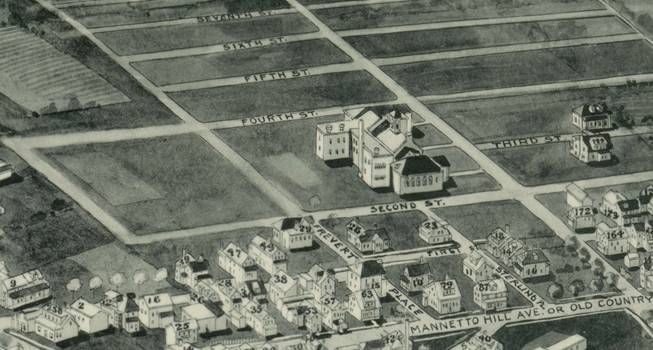
The above snapshot from the 1925 Aero-View of Hicksville (Library of Congress website)) shows how residential development was already encroaching on old farmland, and how close the chosen site was to both existing homes and to future development to the south.

Over the many months that negotiations for the site continued, the Board engaged the services of architects, and plans for the building evolved. I have not been able to determine how the architects - brothers H. Errol Coffin and Kenneth Ford Coffin, both graduates of Cornell - were selected. Their partnership, formed in 1919, was too new to have much of a track record. Later on, the firm went on to distinguish itself over many decades as specialists in educational buildings, designing structures for (among other places) Mattituck, Farmingdale, Glen Cove, Cornell University, and for towns in upstate New York, northern New Jersey, Peru, and Chile.
Discussions between the Board and the architects seem to have been less transparent than the earlier parts of the process. The Long Islander (a newspaper published in Huntington, which is the source for much of this article's content) spoke only in general terms about "plans" and "revised plans," but it did not divulge specifics, instead recommending that those who were interested attend the Board of Education meetings.
When finally acquired, the site comprised 15 acres, more than originally contemplated (of course, many years later the additional acres would provide useful spots for those wonderful additions and the infamous temporaries). By February 1923, all issues related to title of the land had been resolved, and the specifications for bids on construction were being prepared.
In May, taxpayers approved ("unanimously" per the Long Islander, although the vote was actually 86 for, 1 against) an appropriation of $250,000 for the High School building. This amount is curious, for the estimate would have been derived in consultation with the architects, based on their plans and their expert knowledge of construction - yet within months, the estimate ballooned upward by 40%. Either the Board had expanded its requirements following the appropriation, or the architects had been unaware of the cost of their design. Regardless, the Board chose to proceed with it as it was, rather than seeking a less expensive design in line with the appropriation. In November 1923, the Freeport Daily Review noted that none of the contractors' bids had been within the original budget, and that Hicksville's taxpayers had been forced to reconvene, this time voting 143 to 7 in favor of appropriating a further $95,000.
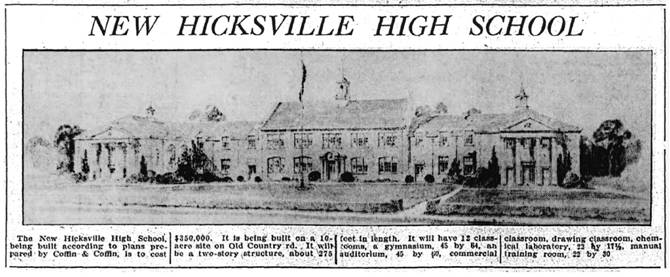
In December the general public got its first glimpse of the future High School when the Brooklyn Eagle published an architect's rendering (above). The caption rounded the cost up to $350,000, and it disclosed some details that had not been published locally: there would be 12 regular classrooms, a gymnasium, a commercial classroom, a room for drawing, a chemistry lab, and a "manual training" room.

A few days before the picture appeared in the Eagle, 300 High School students, teachers, and officials had marched from the old school to the site of the new school. After speeches by a representative of the Board of Education and by each of the four High School Class Presidents, ground was officially broken by one Mr. John Hahn, reportedly given the honor because he was among "the oldest residents of the village present" at the ceremony. In reality, he was a prominent citizen, a successful insurance broker and real estate agent who 15 years earlier had worked with other local "movers and shakers" trying to build a trolley line between Hicksville and Amityville. Per the data recorded on the 1925 State Census, the supposedly aged Mr. Hahn was only about 62 years old at the time of the groundbreaking.
Within 2 months, the foundations were poured, and the first floor's masonry work was in-progress. As the building took shape, someone - it is not clear who, whether architect or Board member - looked things over and decided that an additional staircase, not part of the specified design, should be added to the building, and all parties agreed to the change.

Despite the increased appropriation, money for some items - as often happens today - had to come from other sources. Among these items was the flag pole; the Charles Wagner American Legion Post agreed to undertake its funding. One of the Post's fundraisers for this purpose was a theatrical production staged by the Ladies Auxiliary, whose members were tutored for the occasion by a highly-regarded actor of the day.
Construction on the building progressed so quickly that on April 26, 1925, the cornerstone had to be laid earlier than first planned (i.e., part of the construction would have had to be delayed if the cornerstone was not in place by May). At this point, the second-level floor and walls were taking shape. The rapid pace continued over the summer, so that by September, the new High School was ready to accept students.
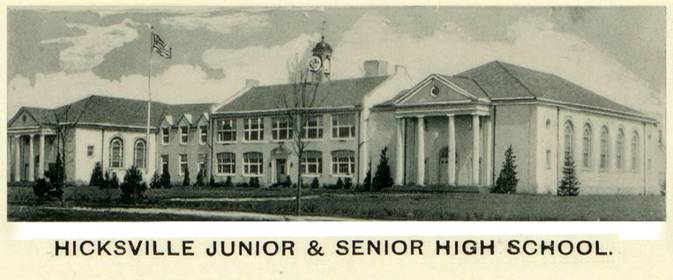
As this awkwardly-retouched 1925 picture (note the painted-in clock) illustrates, the exterior of the finished building differs only subtly from the design originally presented. Differences include the lack of cupolas on the wings, slightly larger windows on the front facade, a more prominent tower, and a more massive character over all. Although the net effect is less delicate than the original concept, it is still attractive.
A setback occurred at the very end of the school's first December. According to the Long Islander, cold weather caused "every pipe" in the school to burst. The report contemplated only the anticipated plumbing bills. It did not mention any resultant water damage, nor any liability to be assumed by the architects or contractor, for failing to ensure that the pipes were adequately insulated from cold weather.
Built for a changing Hicksville, the school immediately triggered further change.
For example, although High School students in Hicksville had competed in other sports, organized football had never been played in the village. On September 20, 1925, the Eagle reported that Hicksville High School was organizing its first football team ever, and that its coach anticipated challenges, primarily because almost no one on his fledgling squad had ever played football! This inexperience was glaringly evident a few weeks later, when the Times reported that Manhasset had defeated Hicksville, 58-0.
Moreover, the school sparked further development of Hicksville, especially in the neighboring open land which had adjoined the site on 3 sides. As the building neared completion, so did new houses. It was a great advantage to Hicksville parents if they lived near the High School with its generous playing field, where even young children could play safely in the summer. Real estate listings like this one from June 1926 were sure to emphasize proximity to the school grounds:
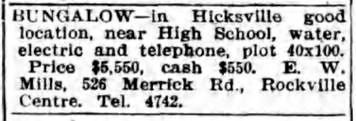
Although the High School momentarily brought Hicksville up to date, it immediately encouraged the long-term growth that would necessitate its own replacement 30 years later - but that's another story.
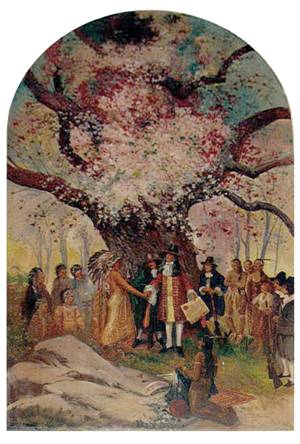
Post Script
The familiar murals in the auditorium (including Early Hicksville, right, which depicts Robert Williams' land purchase of 1648) were not part of the original building. They were painted in 1936 by Joseph Allen Physioc, as part of a Works Progress Administration project. One can learn more about the building's "New Deal Murals" at http://www.wpamurals.com/hicksvil.htmmural
Comment on this article
My First Trip to Lithuania - Summer 1978
by Dr. Giedrė Maria Kumpikas (former Hicksville High School teacher)
Lithuania had been shut off from the Western world since the summer of 1944. My parents had fled the oncoming Russians, barely eluding them by twenty kilometers and avoiding deportation and death in the Stalinist Labor camps in Siberia.
Many years passed. First, five years as refugees in Germany; then almost thirty years as immigrants in New York. Life had been hard for my parents. They had lost their country, their relatives, their honored position in society, and had become factory workers. My mother, due to her linguistic ability, learned English quickly and was able to obtain an office job, later a job as an artist coloring photographs. Many, however, remained factory workers, although most had university degrees. Throughout these years, we progressed ever so slowly and finally bought a house in the suburbs, then nine years later, we upgraded to a better one. I graduated from college and even earned a PhD.
The memory of Lithuania, fleeing the Russians, was an ever-present factor to my parents and passed on to me as well. Lithuania! Where was it? It had actually been eradicated from the world map, yet I knew it existed, although now it was called the Lithuanian Soviet Socialist Republic. A Republic? Hardly. People could not leave; they could not write to anyone in the West, could not attend Church for fear of reprisals; lines for food and other daily necessities were long, and it was uncertain as to whether the staples would be there when your turn came.
In New York, social groups were formed, young people went to dances, and even traveled to Boston, Philadelphia, and Cleveland for a Saturday night dance. The desire to cling to one’s roots was strong.
Nevertheless, the yearning to see one’s Native land never faded. Hardly anyone had been able to travel into the Soviet bloc while Stalin was alive, except some very left-leaning people, who were suspected of being “sympathetic” to the Soviet regime. I had always found it ironic that these sympathizers had chosen to flee rather than stay, but here they were, safe in America, the land of the free, and yet spouting their Communist philosophy.
However, upon Stalin’s death in 1953, people were finally able to correspond. When my mother received her first letter from her oldest sister Julia, who had remained in Lithuania and had not been deported like her other sister, she was overwhelmed to read that her mother, my beloved grandmother, had died, and she had not known when, neither the month, nor the year. My mother cried quietly and bitterly at the political cruelty of heartless leaders who cared little for humanity.
With Khrushchev, the situation became more relaxed and, in 1978, I began to toy with the idea of going to visit my Native country. I did not want to go with a tour, because they were very regulated, so I ventured to apply for a visa with the then Russian Intourist Agency. To my surprise, I was granted a five-day visa to enter either from Poland or Russia. From Russia, oh no! I chose to travel to Lithuania from Poland by train after flying from Paris to Warsaw.
Warsaw! I had a first cousin in suburban Warsaw whom I had not seen since I was three years old. She had been corresponding with my mother over several years, since Poland was less restricted. So, upon my arrival, she and her husband met me at the airport in Warsaw. I also met an American college professor who invited me to a cocktail party that evening at a rich Polish businessman’s home.
My cousin and her husband lived on the fifth floor of a typical Soviet project-type building. It was uniform like all the others, unidentifiable from the outside by any architectural characteristics. A piece of cement block - gray and dreary. The steps were of cement; the railings were iron bars. It had a creaky elevator which smelled slightly of urine. My cousin had a pretty apartment, light and airy, decorated mostly in brown - an oriental pattern brown rug, brown bulky furniture which seemed incongruous in a small space, and brown patterned wallpaper with light beige flowers. I asked her about the color scheme. Why was everything shades of brown? She answered that that was what Moscow had approved, and so nothing else was available.
My cousin gave me a ruby ring, which she said our grandmother had given her to give me if she ever saw me again. I cried.
That evening, I had agreed to go to the reception with the college professor I had met at the airport. He seemed respectable. We drove by taxi into the center of Warsaw. What a difference in the building! It was not by Western standards grandiose, but one could see it was one of the old stately houses in a former affluent area. The apartment was tastefully furnished, no brown tones. The guests were well-dressed; the women elegant, the clothes were Western. I had just come from Paris, so they seemed to be approving. Everyone spoke English; the liquor was imported. Apparently, the host was a wealthy businessman who had a famous jelly donut business. It was a cultured and polite evening.
When we left the party, my escort suddenly announced that he would not accompany me to my cousin’s home due to jet lag! I had made a mistake of not taking any money with me, so he gave me an amount he thought sufficient for the taxi ride and left me. The taxi driver drove around the outer suburbs for quite a while looking for my cousin’s building, but since they all looked alike, he finally ordered me out of the taxi and took off! It was two o’clock in the morning! I was alone in the middle of dark buildings, in a foreign country. I did not speak Polish. I did not know where to go or in which direction to turn. I calmed myself down as best I could, telling myself that I was an American and that I would find a solution. Then I saw a man walking carrying a briefcase. Well, I thought, he must be a serious man, because he has a briefcase. I ran over to him and began showing him the address on a piece of paper, speaking in every language I knew. He was quite astonished at seeing a well-dressed young woman all alone at such an hour, but he was polite and began to walk around with me, looking for the building in question. After a fruitless effort, he saw another man with a briefcase. He went up to him; they consulted with each other and apparently clarified the mystery of where my building was, and the first man walked me to the right building. I recognized the entrance and thanked him profusely. He, like a true Polish gentleman, kissed my hand and said Good Night.
The train ride to Vilnius: My first impression as I got into the Polish-Russian train was that I was in a James Bond film. It was dreary, shabby, and definitely not luxurious. A rather heavy square-shaped woman in a uniform, and thin legs and clumsy shoes, walked quickly down the corridor shouting: “Tchai” (Tea). My Polish travel companions in the compartment smiled at me. She was a caricature of the Soviet employee. One could immediately feel the difference between the Polish people and the Russians. The Poles were not as subjugated as the Lithuanians. Their country was still Poland, a separate, identifiable country. Lithuania was the “L” in the L.S.S.R., no longer belonging to itself.
I learned that to travel to the U.S.S.R. by train, you were obliged to sit in a specific car, in a specific compartment, in a specific seat. Everyone obeyed for fear of being arrested. We settled in. Then the military security came in to verify our documents. I was quite a sensation having an American passport. The young soldiers were polite, clean-shaven, and all carried machine guns. They were pleasant and departed. I thought that would be it for the security check, but this was repeated several times until we got to the Polish-Lithuanian border. At the border, something quite extraordinary took place - the changing of the wheels on the train cars. Since the gauge on the Russian tracks was wider than on the Polish tracks (or vice versa) to prevent the hijacking of a train across the border, every car of the train had to be lifted, the wheels changed, and replaced by wheels appropriate to the tracks. This knocking and clanging lasted for four hours, during which time, no one was allowed to use the toilets (they were locked; someone might hide and try to escape into the Russian zone). There was a lot of banging under the cars, ostensibly looking for escapees. Once again, the armed guards came in to check our documents and asked if we were bringing in any pornography or any religious articles. I had some holy medals for my aunts, which were confiscated.
But later, in Vilnius, I saw women selling rosaries on the Church steps. Throughout the night, we were hardly allowed to sleep. They came in to check periodically. I presumed that it was a Soviet tactic - to exhaust people. As the train pulled into the station in the early morning mist, I saw the sign - VILNIUS!
It seemed unreal! There was such a city! There was such a country! Lithuania had seemed like some sort of forgotten dream, a city lost in time. As I stepped out of that rattling Russian-Polish train, a large group of relatives surrounded me, spun me around, kissing me, telling me their names - I am Marytė, I am Liva, I am Romas, and so on. I only recognized my uncle from photographs, and maybe one cousin. I was probably one of the few Westerners to come into the still deep Soviet Union of 1978 and the first close member of the family. I had only met my uncle as a child, but I had no remembrance of him except a feeling of his kindness. And when he spoke, tears welled up in my eyes. It was my father’s voice, the same quiet, slightly husky tone.
They took me to my cousin Marytė’s apartment, where the table was spread with many Lithuanian foods. And of course, Champagne and Vodka. I later told my friends that I drank nonstop for five days because everyone received me graciously, and it would have been impolite to refuse. We sat around a small table in the living room (there was no dining room), the apartments were usually four rooms - a living room, a kitchen, two bedrooms, and a bathroom (the toilet and the actual bathroom were separate). My cousins and their children sang songs from Žemaitija. I filmed everything, and when my father later saw these films of his sister and brother, he wept.
My cousin’s husband Romas volunteered to be my guide and show me around the city. Vilnius was charming, especially the Old Town, which the Soviets had mercifully left intact. There were ancient cobblestone streets, arches into courtyards, and many amber shops, because Lithuania is the land of amber. I bought a beautiful amber bracelet, from “under the table,” as the saying goes. I learned that people had adapted to a new way of dealing and communicating within the Soviet system. One did not know whom to trust, who would be an informer, who would betray you consciously or unconsciously. So, people kept to themselves, closed in within their family circle or very close friends. Political opinions were unvoiced or expressed in generalities. When asked, “How is everything?” The answer would be, “Normal. You know.” Formulaic answers to formulaic questions. This was all to safeguard themselves against suspicion and possible imprisonment or deportation. It was a Totalitarian rule.
Being from a free country, I walked into that world not suspecting anyone of my relatives to be sympathetic to that system. My cousin’s husband apparently was. However, he was jovial, amusing, friendly, accommodating, and drove me where I wanted to go. First, we went to the apartment building where my parents had lived. My mother had always told me how beautiful their apartment was. It was on a prestigious tree-lined street, and I would easily compare it to Park Avenue in New York. I decided to climb upstairs to the second floor and see if the people living there would let me in. But when I came to the door, I saw four Russian names. That beautiful apartment had been subdivided into four separate living areas. I backed away, trying not to imagine what it had become. The idea was upsetting - an intrusion into my beautiful childhood memory.
Then, he took me to visit my mother’s youngest sister, Maria, and her husband Linas. They lived in an old pre-Soviet building, much different from the ugly Soviet bloc projects. Their apartment had high ceilings and an air of old elegance. I was beginning to understand that the Soviets liked an ugly, gray look. I had first seen it when I passed through Belgrade in Yugoslavia on my way back from Greece by train. Everything was gray, dusty, depressing, as if nothing had changed since the war. There was no brightness in the houses, nor on the faces of the people. My aunt gave me an album my father had left with her for safekeeping when my parents fled. It contained clippings of his historic flight from Prague to Kaunas in 1934 with photographs of his landing. It was a treasure, upon which I later built my film “Wings to Remember” in 2007. I flipped through it in the car, and some of the photographs showed my father’s emergency landing in Germany. My cousin’s husband immediately asked to keep it overnight and read about the flight. I reluctantly gave it to him. When he returned it the next day, two photographs had been visibly ripped out! I asked him to explain, but he lied and denied that he had done so. I realized then that he had either done it to protect me or he had given them to the KGB to ingratiate himself. But I was in a dangerous country, and I did not make too much of it, but my confidence in him was gone. The system had done its work - there were adherents everywhere, even in a family circle.
Although it was forbidden for tourists to go further than twenty-five kilometers outside the city limits, nevertheless, because of this affiliation, Romas took me to Kaunas, where I had been born, to visit my uncle again. They were the most gracious family - a family of an old noble line, subjugated by a cruel regime. But my uncle was a high-level professor of engineering, and because of his academic stature and accomplishments, he had succeeded in avoiding joining the Party.
Romas also took me to Trakai, the medieval castle outside of Vilnius, and to Palanga, the beautiful resort on the Baltic. It was a cold and windy day, but I decided to take a dip in the sea anyway, because it would be my only opportunity. My cousin Kazys stalwartly joined me.
I should mention that we were followed everywhere by security people in the proverbial black car. The resort had walkways lined with fragrant pines and the sand was so fine that one could barely feel it. It was almost white; hence, I suppose, the name “Baltic” because “baltas” in Lithuanian means “white.”
My mother’s side of the family was not numerous. Besides my youngest aunt and her family, I also had my cousin-godmother Aldona and her family. Her parents and two siblings had fled to the West. She had been cut off and left behind. Her fiancé had been arrested by the Soviets and shot. She was a very intelligent woman, had earned a Doctorate in Chemistry, had become a professor, had married a linguist, had a family, but was extremely fearful of the system. I admired, pitied, and liked her.
My mother’s second-oldest sister Ziutė had spent twenty-four years in Siberia, where she had been deported with her husband and three boys. They were some of the fortunate ones who had now been able to return. Her second son, Stasys, had organized the repatriation, and they were all living in Alytus, a town famous for its pine forests. Her husband, a former Captain in the Czar’s Army, had died, and she was living there with her son, his wife, also a Siberian orphan, whose parents had disappeared somewhere in the taiga wastelands.
Stasys came with his wife and two sons by car to my hotel, and when I asked where my aunt was, he answered that she would come alone by train. I was quite surprised. My aunt was eighty-two years old. When she did come a little later, I felt her indomitable spirit. She had survived the Siberian Concentration Camps, innumerable hardships, starvation, Malaria, and still had an angelic presence exuding warmth, compassion, and love for humanity. I remember she did my fortune, predicting all sorts of good things, and she gave me her national costume. It was the only thing she had to give me, and a small lace hand-embroidered collar. I had tears in my eyes as I accepted these humble gifts from a woman who had little and had suffered much. She also showed me the manuscript of her memoirs from Siberia and read parts from them. It was heartbreaking. Then, I made her a promise someday to print and publish them, which I did many years later. At the time of our meeting, I was afraid to take them with me for fear of them being confiscated.
After five days of reunions, tears, reminiscences, it was time to leave. Thirteen people came to see me off at the train station. Being superstitious, I had a bad feeling as I looked at the group. Some weeks before, a lovely friend in Paris had invited me to an afternoon luncheon at her home and when she counted the number of guests, there were thirteen. She became worried and said she would have to set two separate tables so as not to seat thirteen people at the same table. I had asked her why. She answered that it was bad luck, that someone would die before the end of the year. So, when I saw my thirteen relatives and one friend, a group of thirteen, at the station, a chill ran over me. People who are not superstitious will make fun of this, but I no longer do. That year, my youngest cousin, barely twenty-nine, died of a heart attack. My readers may think as they like, but I never seat thirteen at a table, nor will I sit at a table with thirteen people. I do not know where this superstition comes from, possibly from the Last Supper. The train ride back was a replay of the one before, except that when the security police came in to check our documents, they asked me to open my suitcase, the one where I had put my father’s album. They immediately found it, as if they had known where to look, but Romas had given me an official letter that the album was personal and contained no political undermining. So, perhaps he had ripped out the two photographs to protect me after all.
And so, my first trip to Lithuania was memorable in many ways. I had vague remembrances, little vignettes, of my early childhood years. I had met my dear relatives; I had seen an example of a country under the Communist regime - inferior building architecture, lines for products, empty supermarkets (but plenty of Vodka), and a fear of expressing one’s thoughts.
Some images stayed in my mind: men drinking at an outside stand early in the morning before going to work; a small single Soviet car, a green Moskvich, driving along a wide avenue all by itself. The furniture was brown, but the cars seemed to be predominantly green, ostensibly another Moscow allowance in car paint.
But there was much beauty as well: the streets were immaculate, no trash anywhere; the old Metropolis Hotel whose heyday had been in the 30’s, with its plush red velvet seats and white (or was it gold) painted French-style furniture, a vestige of its elegant past where famous orchestras had played fox-trots, waltzes, and tangos to a well-dressed public; the quiet park-like Petrašiūnas Cemetery in Kaunas with its extraordinarily beautiful individual monuments, and majestic trees. Yes, this was the country of my birth, the land of my fathers. I was moved to tears on many occasions and lost many of the preconceptions I had had. The world my parents had left behind had moved forward as had theirs in America, but differently. In Lithuania, people had retained their language, their culture, and their customs. We had to adopt and adapt ourselves to a new language and new customs. The question of identity began to arise in me. Who was I in this land? A stranger? Somewhat. A tourist? In a way. But I was a romantic and drank it all in, trying to tie together my wartime experiences and childhood recollections with my new culture and way of life. All these thoughts matured more deeply over time, but this trip had reconnected me with a reality I had forgotten, and which had been replaced by a new reality, including the joys and exuberance of my youth in America.
Giedrė Maria Kumpikas
East Hampton, New York
July 31, 2025
Comment on this articleThe Class of 1965 is Planning its 60-Year Reunion!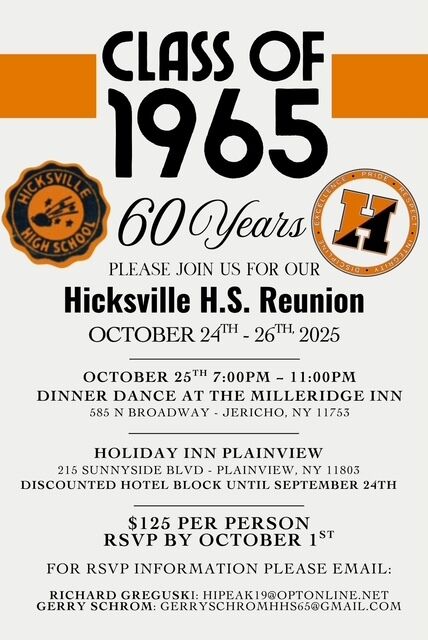
The Hicksville High School Class of 1966 is planning its 60-year Class Reunion!
Date: Saturday, April 25, 2026
Location: Hicksville Knights of Columbus
Cost: $50/person
To Register: Send a check to Stephen Goldstein, 1111A Washington Drive, Centerport, NY 11721
Comment on this article🎉 HHS Class of ’69 Mini Reunion 🎉
The votes are in!
We’re excited to announce
our Mini Reunion will take place on Saturday, October 18, in Long Beach, NY
📍 Where:
Party room at 711 Shore Road (Nancy Schwartz Costo’s condo – thank you, Nancy!)
🕕 When:
6:00–10:00 PM
Plenty of local spots nearby if you want to hang out after!
Cost:
Estimated between $50.00 - $75.00 per person. We will provide the actual amount for prepayment once we have a headcount and confirm with the caterer.
🚗 Parking:
Instructions on where to park will be provided later!
🍷 BYOB & SELF-SERVE BAR
📌 Important Dates:
- RSVP deadline: Sept. 27
- Payment due: Oct. 4 via Zelle or check.
An email/FB post will go out shortly after the RSVP deadline to give you the final ticket cost.
🚫 NO PAYMENTS AT THE DOOR — sorry, folks!
🏨 Hotel Options in Long Beach:
- Allegria Hotel – 80 West Broadway
- Long Beach Hotel – 405 East Broadway
Both have restaurants, bars, and offer breakfast.
📧 Got questions?
Email us at:
Let’s make it a night of hugs, laughter, and memories. Can’t wait to see everyone again! 💛💙
- Diana (D’Antuono) DePalma-Henne
- Nancy (Schwartz) Costo
#HicksvilleHigh1969 #HHSClassof69Reunion #MiniReunion #CatchUpAndCelebrate
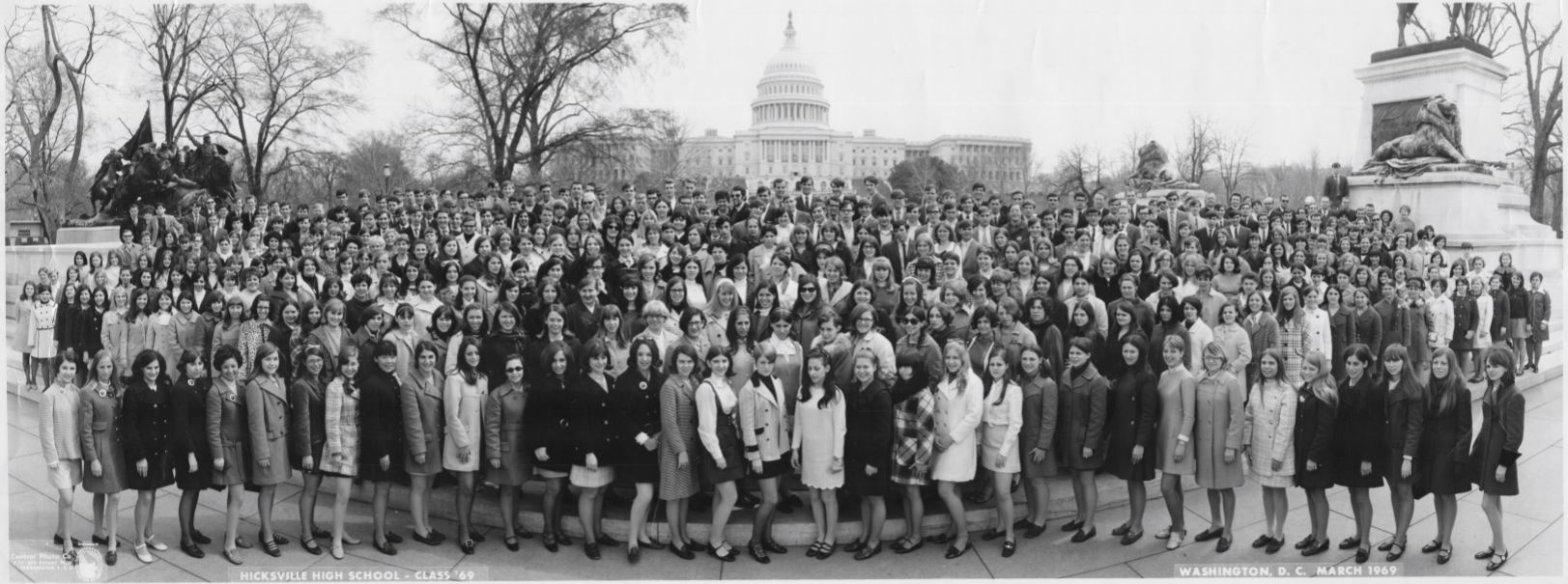
Etcetera for August 2025
William Palmer commented on Volunteer Firefighter: "Thanks for sharing this. A special treat was to see the lovely offerings of Dr. Kumpikas as well. She was my homeroom teacher at HHS, and I was delighted to be able to introduce my wife to her at our 55th reunion several years ago. I hope we both convey the message that age is just a number, and we never have to stop offering our gifts to others. Bill Palmer, HHS Class of 1964"
Peter Foster commented on Volunteer Firefighter: "Obviously, you are a dedicated caring American. God Bless."
William H. Canham commented on Hicksville is Everywhere: "It really is a small World. I can feel your excitement you described. To this date I still have a small group of my good friends . We graduated in 1961. Hicksville bond just lives with you always."
Lesley Brevick Lyons commented on Hicksville is Everywhere: "Husband (class of 66) and myself (class of 70) met and got married after my husband came home from four years in US Navy....my husband knew my brother who was also class of 66. OLLI - love to hear about your participation. After retiring nine years ago my husband and I found OLLI Cincinnati...we have taken many classes on line and in person over the years. Your class sounds very interesting...keep up the good work...nice article"
In Memoriam
Richard Zodda, Class of 1964
Barbara Buckley Balsan, Class of 1973 (10/25/55-10/5/18) She passed 10/5/2018 from lung cancer, she fought hard for two years. She and her husband, Kenneth Balsan have 3 children together: Brian,Melissa and Kenneth. They have 8 grandchildren Nicholas, Gianna, Sophia, Julia, Jackson, Jamison, Catalina, and Julian.
Denise Gail Wright Hauk, Class of 1975 (June 18, 2024)
Dr. Mark David Ludman, Class of 1972 (August 2025)
Comment on this article
We are including a listing of the Nassau County free summer concerts.
Comment on this article

